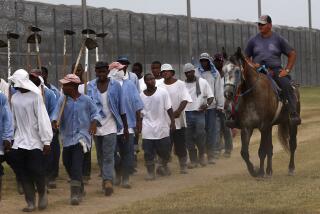Castle Tours: Painful Trips to the Past
ELMINA, Ghana — The centuries-old stench of mold and human waste still rises in the small cell with a narrow, barred door that opens to the harbor--the last spot where African slaves touched the continent before being shipped to the Americas.
Eugene Vickerson, a 53-year-old retired real estate salesman from Atlanta, peered into the gloomy dungeon lit only by a narrow ray of sunlight slanting through the notorious Door of No Return. “I cried yesterday when I visited some of the other places, so today I’m doing pretty well,” he said with a rueful smile.
Last week, Vickerson became one of a growing number of black Americans who come to see St. George’s Castle and others among the 30 forts along Ghana’s coast that once warehoused millions of Africans sold into slavery. “I am just overwhelmed with emotions,” he said. “It is all so much more real when you see this.”
Historians now estimate that 60 million Africans were captured as slaves in West Africa between 1503, when the first slave purchase was recorded here, until the commerce finally withered in the 1850s. Only one in three slaves survived imprisonment in castles like this and the voyage across the ocean, meaning about 40 million people died in captivity over about 350 years.
Portuguese traders were the first Europeans to venture along West Africa’s coast in search of gold and ivory. Finding gold available from tribes in this region, they named it Elmina--the mine--and began building the castle in 1482 to store their goods between visits by trading ships. The Roman Catholic chapel within its walls is the oldest Christian church in Africa outside Ethiopia, according to published histories of the fort.
By 1600, with Europeans in the Caribbean and North America seeking cheap labor, the fort’s dank storerooms were holding African captives as well as other goods.
Clifford Ashun, a guide here, said that about 20,000 foreigners visit the castle each year and that “black Americans are the very large majority. More come every year. Often they offer libations to the ancestral gods and cleanse themselves. It is very emotional.”
Increasing numbers of African Americans have visited Elmina and slave castles in other West African countries, most notably Goree Island off Dakar, Senegal, where President Clinton stopped during his July 1998 Africa trip.
Vickerson, who came to Elmina with Ghanaian friends, said he was the last of his circle of African American friends to make the pilgrimage to the slave castles. “It was something I felt I had to do,” he said.
“It is my first time here physically, although I have been here many times before in my mind,” said Vickerson, who studied African history in college in the 1960s. “My overwhelming sense is that the racial question still exists, the oppression continues. Not that much has changed; that is what is so sad. We know bad things happened and there was terrible suffering, but it continues in different forms, in different times.”
Even restored and empty, the cramped cells--their air damp and stale--still seem to carry the smell of the thousands of men and women who lived and died inside. Often, several thousand at a time were jammed into the cells and fed once a day. There was no toilet or any way to bathe. Men, held separately from women, were chained together.
The captives stayed an average of three months while awaiting the ship that would take the survivors to the New World. Any who rebelled risked being locked in the Cell of the Condemned to starve, their bodies thrown into the sea as a warning to others. If more than one person was in the cell, the room would not be emptied until all had died, according to Ashun and published histories.
When a ship arrived, the captives were taken in groups toward the cell over the harbor, with its Door of No Return. In the next-to-last room, a fire burned, heating the branding irons that the slave traders pressed into the flesh of the African men for identification. Weak from disease, more died here.
The European soldiers and artisans lived over the slave quarters, and the fort’s officers on floors above. From his apartment on the fourth floor, the fort’s governor enjoyed not just a spectacular view of the sea and a constant breeze that kept the stench away, but also a private balcony that overlooked the courtyard of the female slaves. From there he pointed out the women with whom he wanted to have sex. Those chosen were bathed in the courtyard, then taken to his chambers by a private stairway. If the woman was later found to be pregnant, she was freed and lived in a special house in the town. At the age of 3, her child was taken from her to be educated by priests and trained in a profession.
Because of the lucrative trade in slaves and gold, Elmina became coveted by other world powers, and in 1636 Dutch troops captured it with the help of local tribes, who believed the Dutch promises that they would not trade in slaves.
Instead, the Dutch strengthened the fort, converted the church into a large slave-trading hall and expanded the trade. In 1872, with the gold depleted and the slave trade banned, the Dutch sold St. George’s to the British, who were consolidating the colony they called the Gold Coast.
Now, as a historic site, the fort should draw not only Africans and African Americans, but also whites, Vickerson said.
“In the 1960s, we always said that history is not just for the oppressed but for the oppressor,” he said. “That is still true today.”
More to Read
Sign up for The Wild
We’ll help you find the best places to hike, bike and run, as well as the perfect silent spots for meditation and yoga.
You may occasionally receive promotional content from the Los Angeles Times.






